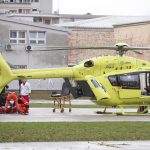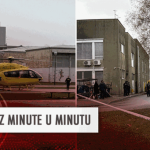As Korana Sutlic/Novac writes on the 9th of May, 2020, Vedran Mimica, a professor of architecture and urbanism at the Illinois Institute of Technology (IIT) in Chicago, has now, and previously at the Berlage Institute in Rotterdam, dealt with tourism. He is currently in Chicago and Novac got in touch with him with the help of Zoom, through which he also holds regular classes in graduate, postgraduate and doctoral studies. For Jutarnji list, he talks about global and Croatian tourism.
In what direction, globally, could tourism go after the epidemic?
Tourism is the world’s leading industry and not only contributes to 12 percent of the world’s total GDP but is also one of the basic phenomena of postmodern society. The country we studied the most at the Berlage Institute is China, the world’s second largest economic power in which tourism is growing in an almost unbelievable process of about 18.5 percent of annual ”outbound” tourism, meaning tourist traffic representing Chinese stays outside of China. This is a significant share in the global development of tourism.
Interestingly, only six percent of Chinese actually hold a valid passport and can travel, so that is equal to 84 million people. The Chinese spent 257 billion US dollars on travel outside of China last year. It is to be expected that many more Chinese citizens will also soon hold passports. At the same time, 46 percent of American citizens have a passport and spend “only” 135 billion US dollars a year when abroad. It’s also interesting to note that in the first half of 2019, Chinese tourism increased significantly compared to travel to Europe, and in the case of Croatia, by more than one hundred percent.
For many, it’s also important how much the guests actually do spend. The Chinese used to travel in groups and follow arrangements, and now they travel more individually and spend much more money when they do. In addition to giving Croatian tourism a boost, they also increased their visits to Latvia, Slovenia, Bulgaria, Estonia, Serbia, Malta, Ireland and Denmark. I was in China last December and the growth of their standards is obvious, so I believe that after the coronavirus pandemic passes, when the global situation returns to a kind of normalcy in the foreseeable future, tourism will continue to be one of the main sources of the economy in most parts of the world.
That’s why I believe that global tourism will not be in a critical situation after the coronavirus pandemic is over. The critical question is when will we have a vaccine and when will the coronavirus epidemic come to an end.
What is it that makes tourism so attractive to people?
That was the very reason for our research, creating a social image of the tourist experience, how to connect what we have as tourist destinations and how to build cities in the future that will seriously accept this phenomenon of tourism. Michel Houellebecq says: ”What I really want is basically to be a tourist”. Architect Rem Koolhaas will say: ”Today we’re not building cities, we’re building resorts. Resorts have become basic urban DNA.”
If we imagine tourism as the result of a basic binary division between the ordinary, the everyday, and the extraordinary, then perhaps we need to accept our postmodern situation as a constant desire for extraordinary experiences.
When could tourism stabilise again?
That’s currently the question above all other questions to which there are various answers. From the people who are claiming that we won’t shake hands again until 2023, to those who insist we all have to go to the beach now. The tourism industry will be significantly affected by the economic damage from the pandemic on a global and individual level, especially in the first wave of recovery.
Whenever there is a crisis, we’re inevitably instructed in a new way of thinking and opportunities to learn something from the crisis. I’m not close to thinking we’re going to learn all that much. It has been debated for some time that we entered the Anthropocene a long time ago, from the middle of the last century, and that global warming and climate change, if we don’t change something fundamentally, will significantly affect life on the planet and will probably be dangerous to it.
There are two views on this situation. One is that people will accept it and that we’ll then move into a period of posthumanist society, meaning a society in which more humanistic values aren’t the most important thing and in which we will socialise with people and non-humans with various algorithms. Some think that there are some interesting possibilities for a posthuman society, while others, of course, think that this is the end of civilisation as we know it and an extension of the crisis. It’s a very interesting discussion, we’re working on it a lot at the academy and in a way, we’re trying to understand how the development of cities and the disciplines of architecture and urbanism can relate to it. It’s my opinion that we’ll very likely have to accept these environmental impacts and adapt to them to some extent or another. The question is what level of invention, imagination and intelligence is required for this kind of adjustment.
What has been wrong so far and what would be good to change after all this?
A year ago, my good friend, architect and academic Nikola Basic, organised a gathering called ”Tourism, space, identity”. He was one of the main lecturers along with Sinisa Topalovic, a tourism researcher from Horwath HTL. I quote Basic: ‘Croatian tourism is on the threshold of development, before which it must slow down its growth and encourage prosperity. This will reduce its increasingly visible negative imprint on society and space… The Croatian tourist pixel must retain its recognisable brilliance and colour”.
Nikola is essentially talking about that new kind of authenticity. Something where Croatia tourism becomes different, in which burritos and burgers will not dominantly infiltrate Diocletian’s Palace, where the slogan of Croatian tourism will not be the Mediterranean as it once was but the Mediterranean as it could be. Basic talks about inclusive tourism that is integrated into the community. If something is good for tourism, then it needs to be good for both the local community and for society as a whole.
At the same gathering, Sinisa Topalovic presented things in an economic fashion and proved that the business model of Croatian tourism is unsustainable. Firstly, because Croatian tourism contributes 19 percent of GDP, and any country that has such a high percentage of tourism impact on GDP is a country that has a problem, and obviously, as we’re now in this situation with the coronavirus pandemic, we’re have some serious problems.
Furthermore, 85 percent of overnight stays take place from June to September, but perhaps the biggest problem is that the income from Croatian tourism is 67 percent lower than it is in countries which are Croatia’s competition. There’s all of that, plus the fact that Croatian taxes that tax the industry, and especially rent, are absolutely inconsistent with the development goals of both society and tourism. One comparison is very indicative – if someone has 20 beds for rent, they will pay 6,000 kuna in taxes a year, while if you work in Zagreb and have an average net salary, you will pay about 4,500 kuna in taxes per month. Such a situation simply does not allow for the healthy development of society. Why work if it’s easier to just rent?
It’s important to create that new authenticity, not a new normality. And it cannot be as it is now – the predominant attitude of Croatian tourism in relation to history, Roman soldiers on the Peristyle, the Peasant Revolt in Stubica. A new authenticity is created by a new society, a new life in cities, a local life that is not a show, and not something fake.
You’re currently in America, will there be no Mimice for you this summer where you have a holiday home?
What do you mean there will be no Mimice? You can’t survive a year without Mimice! I hope to be able to spend three months in Croatia and work in Rijeka on the ECOC project. I’m obviously an incorrigible optimist about all of this. The only thing I would not like is that when I come to Croatia, I have to go to isolation for two weeks. But if necessary, I’m also ready for isolation – but in Mimice!
For more on Croatian tourism, follow our lifestyle and travel pages.








